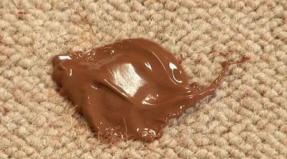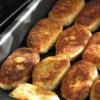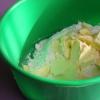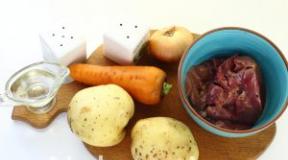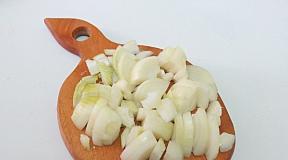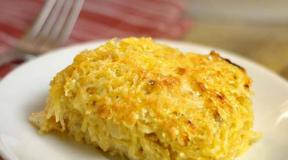How to remove mucus from fresh fish. How to clean sterlet and butcher it for cooking various dishes
A common picture after cleaning a fish is scales all over the kitchen and a nervous hostess. It's even worse if she doesn't know how to approach the fish at all.
How to remove giblets
- It is advisable to gut the fish and remove scales from it at the same time (at least on the same day).
- Need a cutting board. So that the smell of fish does not get into it and to speed up the process of subsequent cleaning, a bag or newspaper is placed on the board.
- Holding the fish belly down, you need to make an incision on it from head to tail.
- Take out the contents with a spoon or knife.
- There is a dark film on the walls of the belly, which must be removed.
- Thoroughly rinse the fish.
How to get rid of scales

- If the fish is slippery (after defrosting), rinse it. In addition, if you sprinkle your hands with salt, the fish will not slip out. You can hold it with a towel.
- You will need a large vessel (basin, bowl), in which the whole fish is placed. To keep the kitchen clean, you can clean the fish in a thick polyethylene bag under running water.
- We moisten the fish with dried scales with water, wait a few minutes and clean.
- First of all, you need to cut off the sharp fins and head (if it is not in the recipe).
- The scales are removed with a special grater, knife, fork and even a teaspoon.
- You need to clean the scales from the tail to the head, that is, against its growth. We begin cleaning with small, sharp movements. First you need to clean the sides, and then the belly.
- After washing the fish, we get rid of adhered scales and evaluate the quality of work.
If the fish is supposed to be boiled or smoked, you may not need to clean the scales. This will save more nutrients. In addition, you can buy fish that have already been peeled. I recommend you try it the same way.
Cleaning by fish species
It must be taken into account that the way how to quickly and correctly clean the fish depends on its characteristics. In particular, mackerel and flounder have no scales. In burbot and catfish, it is very small, almost invisible. The strongest scales are found in pike perch, crucian carp, carp and perch.
Perch

It is very difficult to clean the scales of the perch, so the scales are removed along with the skin.
Zander

The fin on the back of the walleye is very hard. We cut the fish under and above the fin, after which it can be removed.
Horse mackerel

Before cleaning, you need to dip it in boiling water for thirty seconds, because the scales are very hard.
Catfish

After gutting, removing the head and fins, you need to divide the fish into fillets, from which to remove the skin.
Burbot, eel

Make an incision around the head and remove the skin like a stocking. When gutting, the liver of burbot is separated and cooked separately.
Tench

The tench's scales are dense and small, covered with mucus, which makes cleaning very difficult. First you need to put the fish in boiling water, then in cold water. Now you can peel slime, scales and gut.
Hake

It is necessary to cleanse the small scales and remove the abdominal film. The skin of a large fish is rough, so take it off.
Catfish

It is necessary to clear of mucus, gut and cut off the head with fins. If the fish is very large, it can be cut before removing the skin.
Cod

The liver is used for food. There is an abdominal film that needs to be removed.
Lamprey

This fish is not gutted. After removing mucus, rub it with salt and rinse.
Flounder

Scale off the scales from the light side. The dark skin should be cut at the tail and removed. It is advisable to first dip the flounder in boiling water.
Sole

Cut the head from the back and remove the entrails. Remove the skin like a stocking, making a cut at the tail.
Tricks to speed up cleaning
Method 1 how to quickly clean the fish: We put the fish in boiling water for two to three minutes. After that, the scales are easily removed with your fingers under running water.
Method 2 how to quickly clean the fish: Boil the gutted fish. After that, it is much easier to remove the scales and remove the bones.
Method 3 how to quickly clean the fish: Pre-soaking in cool water with a little vinegar.
Before purchasing such a large and rather specific fish as catfish, you should familiarize yourself with the rules for preparing it for subsequent heat treatment. First of all, you need to learn how to clean the catfish. This process is not very complicated, but rather laborious. There are positive aspects to manipulation. Firstly, the skin of the catfish is not covered with scales, so the kitchen will remain relatively clean after the procedure. Secondly, the catfish carcass does not contain small bones, only ribs and a ridge.

Despite the fact that the skin of the fish is not covered with scales, mucus takes its place. The substance is dense, exudes an unpleasant odor of mud. Before cleaning the fish, you must get rid of this formation, otherwise the final product will be hopelessly spoiled. In general, the preliminary preparation of the carcass for processing involves the following manipulations:
- Roll the product in coarse salt or roll in it, with three gloved hands or an old unnecessary napkin.
- We take a knife, turn it with the blunt side and begin to scrape the surface of the skin. This layer of fabric is quite dense, so there is no need to worry about its integrity. Ideally, the areas to be treated should be light in color.
Tip: Failure to make sure the fish is dead initially can result in serious injury. Before cleaning the catfish, you should chop off the tail of the carcass with a kitchen ax. It will not be needed in the post-processing process anyway.

- Now we thoroughly rinse the fish under cool running water, evaluate the result of the work. If necessary, repeat the manipulation again.
Catfish are often cooked right in nature, right after fishing. In this case, it is not necessary to waste salt, the surface of the fish can be cleaned with wood ash. The main thing is to thoroughly wash off this component.
Features of gutting catfish
After the desired result is achieved, you can proceed to further procedures. It is recommended that the anterior fins located near the gills be removed first. They are equipped with very sharp spikes that can cause injury. For this procedure, you should use a kitchen hatchet, large scissors or a cleaver, the thin blade of the knife is easily damaged.

Now we do the following:
- We spread the catfish with its back on the table, in the head area we make a shallow puncture. From it we make an incision along the drawn peritoneum to the very anus of the fish. We act carefully so as not to damage the insides.
- Now you need to expand the incision and clean the belly of the individual, pulling the insides out. You don't need to take them off your head! Damaging something like a gallbladder can ruin quality meat.
- To continue cleaning, the gills must be trimmed. Then they can be removed along with the insides. After that, the surface of the belly must be cleaned of films.
- Next, we make incisions on the outside of the trimmed front fins and pull them out, grabbing them with pliers, working from the tail to the head.
- Sometimes, when you have to clean the catfish, you can find eggs. This is a real delicacy, so we carefully remove the component and transfer it to a clean container. It remains to remove the film from it and the product can be salted or fried.
It happens that even increased caution leads to the ingress of bile on the meat. In this case, you do not need to cut out the affected pieces and discard. It is enough to thoroughly rinse the problem areas, rub them with salt, and after a couple of minutes rinse again.

How to properly separate the pulp, remove the skin and get rid of the smell?
The most difficult thing is over, simple, but very important "cosmetic" procedures are left.
Now the catfish needs to be cleaned as follows:
- Separate the pulp. Cut off the catfish head, put the carcass on its side. An incision should be made along the back, starting from the tail. Keep the blade parallel to the table top. After that, we move the pulp a little and deepen the incision to the backbones. We drag out the meat a little more and we already reach the rib bones. Gently moving the blade along the ribs, first remove the meat from the top of the carcass, gradually moving towards the tail. We turn the catfish over, it is not so convenient to clean the fillet here, so we act more carefully.
- We remove the skin. This is not an obligatory step, since the skin of the catfish is very soft and delicate. But it will have to be removed if you want to use only fillets, for example, for making a kebab. It can also be pulled off the meat, but it is much easier to do this at the stage when the carcass has not yet been disassembled into its components. We put the washed and gutted fish without fins, make a circular incision behind the front fins and a longitudinal incision along the length of the ridge. We grab the edge of the skin with pliers and pull from the head to the tail, if necessary, helping ourselves with a knife. We repeat the same with the other half of the carcass.
- We eliminate the unpleasant smell. It is worth considering that cleaning a catfish at a respectable age is much more difficult than a young individual. And the smell of mud in this case is so pronounced that many housewives refuse to process the component. But there are several things you can do to reduce this strong scent. Be sure to remove the skin, because it is the main source of amber. Additionally, the meat should be either soaked in milk, spending 2-3 hours, or in lemon juice or white wine for 20 minutes. In both cases, the product will not only acquire a pleasant aroma, but also become much softer.

We do not throw away the head and bones left after we managed to completely clean the carcass. They make an excellent broth. The meat itself can be used in a variety of ways. The main thing is not to delay the heat treatment. The component, of course, will withstand several hours of marinating without problems, but a longer stay at room temperature or in the refrigerator will affect the state of the blanks in the most negative way. They will begin to fall apart from the slightest touch, they will begin to exude a smell, albeit not of mud, but of a lying product. And then there will be no way to interrupt or mask it with spices.
Fish deservedly occupies one of the main places on our table. Nevertheless, many housewives prefer not to cut this product, but to buy it already packaged in the store. After all, there is an opinion that it is difficult to clean and cut river and seafood because of the mucus covering the carcasses and the scales scattering in all directions. In fact, it is not difficult to clean and prepare fish for heat treatment, the main thing is to know how to do it correctly.
What you need to clean and cut fish
Many of us prefer to peel and butcher carcasses with a regular kitchen knife. But there are many ways to clean, for which you may need other tools:
- sharp knife;
- scaler;
- grater;
- chopsticks;
- fork;
- tablespoon;
- fishing knife;
- high pressure hose or körcher;
- tin;
- drill;
- rubber gloves;
- kitchen scissors.
A sharp kitchen knife is far from the only device that can be used to clean fish.
How to clean fish properly
Of course, the cleaning of river and sea fish is different. Mostly due to the size of the scales. The saltwater one is easier and faster to clean, as it is covered with small scales, which quickly disappear upon physical impact. However, there are some rules to know to make your job easier.
How to clear mucus
Some types of fish, before removing scales from them, need to be cleaned of a layer of mucus. There are several options for solving this problem:
- Immerse the carcass in very hot water for 15–20 seconds. The mucus will come off during this time, and you can start cleaning.
- The second method is also pretty straightforward. Rub the product with salt before cleaning. The carcass stops sliding in the hands.
- When fishing, you can use sand instead of salt. But this method is not very convenient, because then it is difficult to wash the grains of sand from the meat well.
- For 3 liters. we dilute 1 tbsp of water. l. table vinegar. We lower the carcasses into the solution for 1-2 minutes. Mucus is easily removed.
It's time to catch eels. They said they brought it home. The fish is interesting, but how to clean it from mucus. They brought the fish, put it in a bowl or any other dish and sprinkled the fish with coarse salt at times, and let it stand for 20 minutes. Salt eats away mucus. It remains to rub a little with the remaining salt and rinse with water.
Wladimir
I make it even easier. While fishing, toss the fish in dry sand, with one hand tightly hugged around the nape, with the other you take it by the head and stretch it out. And so several times, it cleans well.
Neighbor
http://www.rybolov.de/poleznye_sowety/aal
And you can also get rid of mucus and not only on eels, but also from other fish with the help of a vinegar solution.
http://www.rybolov.de/poleznye_sowety/aal
The correct way to remove scales
Before starting cleaning, fill the sink, basin or any other container with water. We lower the carcass into the water. This will avoid unnecessary cleaning: the scales will not scatter around the kitchen, but will settle in the liquid.

Instead of a fish scaler, you can use a fishing knife, kitchen knife, tablespoon, or fork. This method is perfect for various types: river and sea. However, with larger individuals, more effort will have to be made.
How to clean fish properly
We clean in fast ways
One of the most effective and quickest ways to remove scales from fish is to clean it with a grater. For this method, we use a grater with 4 ribs, it is more convenient to use.

In nature, instead of a grater, you can use a tin can by breaking through the bottom with nails. Thus, pink salmon, chum salmon, pike perch and other species are cleaned. For individuals with hard scales, you can use the coarse-mesh edge of the grater.

Instead of a grater, you can use a can, punctured with nails.
How to quickly clean a fish with a grater
How to do it with ... a drill
Folk methods are often unusual, but nevertheless effective. We will show you how to clean with a conventional drill:

Scales from river and sea individuals are removed with a drill. She perfectly copes with both small and large hard scales.
Cleaning video tip
Cleaning with KARCHER
This method of cleaning fish from scales is convenient in nature, in the country or in the courtyard of a private house:

This method is convenient for cleaning large specimens. Small fish will not be able to withstand the pressure of the water and will fall off the retainer.
Scale cleaning with a kercher
How to clean frozen
Many experts advise thawing the fish before removing the scales. But there is often not enough time for defrosting. Can I clean a carcass just removed from the freezer? It is possible, because frozen products are quite easy to clean from scales.

The method is perfect for small fish weighing up to 1.5 kg. It is better to defrost carcasses weighing more than 1.5 kg so as not to get hurt when cleaning and cutting. This method is used to remove scales in river species: crucian carp, perch, bream and others, as well as in marine fish, including salmon.
Frozen Fish Processing Videos
Evenk way of cleaning
In the north, this method is used constantly, it is convenient and easy to use:

The method is interesting in that even when cleaning fish with small scales, only the scales are cut off, not the skin. It remains intact. Thus, in the north, all species that have been frozen are cleaned.
Cleaning fish from scales in Evenk style
How to properly cut a carcass
After removing the scales, the fish must be cut in order to then proceed to the cooking stage.

How to gut with Chinese chopsticks
This method of gutting fish is used when it is necessary to keep the carcass intact.

How to gut fish in the Chinese way
How to cut fish in different ways
Butchering fish products can be done in different ways. It depends on how we are going to cook them.
How to quickly fillet
To quickly and efficiently cut fillets, we need a sharp knife.

This method is also called "Finnish". It is more convenient to use a knife with a long blade for cutting.
For portioned pieces - "round"

For stuffing
Basically, fish is stuffed either in portions, or whole.

Another way to cut fish

For minced meat
- We cut the fish in the same way as for fillets.
- Remove medium-sized bones with tweezers.
- Scroll the meat through a manual meat grinder 2-3 times.
- Simmer the minced meat for 1-2 minutes until the smallest bones, which could get into the minced meat, are completely softened.
- Minced meat is ready.
When using this method, a manual Soviet meat grinder is indicated. Other household appliances can also be used: a food processor, blender or electric meat grinder. But a combine or an electric analogue of a meat grinder does not grind fish bones so finely, there is a great risk of injury after eating ready-made minced meat.
I often make silver carp cutlets. I buy a whole silver carp, rip off the skin along with the scales, it shrinks like a stocking. I cut off the meat from the ridge, it turns out two fillets without large bones. I grind it in a Soviet meat grinder, all the bones remain in the meat grinder, and already from the minced meat I make delicious cutlets.
AntiTrol
I made minced meat in a combine, it turned out to be airy, but the combine does not grind bones, once I tried it.
Anna
http://sovet.kidstaff.com.ua/question-678004
Features of cleaning and cutting fish
- When cleaning and cutting salmon: salmon, pink salmon, chum salmon, salmon, and others, you can not peel the scales, but cut the fillets from the skin.
- Small perches can be scraped off the scales with your fingers. It is enough to scald the carcass with boiling water and remove the scales.
- It is better not to peel off the scales from the flounder. Remove the skin from the tail to the head along with the scales. To do this, we make a small incision at the base of the tail and pry off the skin.
- When cleaning and cutting carp, it is very easy to get rid of small bones. We make frequent cross cuts. When cooked, small bones are softened by heat.
- Small bones from herring, trout, rudd, omul are removed with tweezers.
- Small fish such as capelin or sprat are cooked whole. If we are still afraid that the bones will get caught in the ear, we can boil it in a gauze bag.
- When stuffing, the eyes and gills are necessarily removed from the head of the carcass.
- If the gallbladder ruptures during gutting, wipe the place where the bile got into with salt.
- For the preparation of minced meat, it is better to choose large fish: salmon, catfish, pike perch.
As we can see, quickly peeling and cutting fish into fillets, minced meat or portioned pieces is not difficult at all. The fish retains its structure and taste with any method of cleaning and cutting. Now you can be sure that fish dishes will delight you not only with amazing taste, but also with excellent appearance.
- carefully rip open the belly, first making a small incision under the head;
- we take out the insides so that, God forbid, we do not damage the gallbladder (the leaked bile will add bitterness to the meat);
- remove the inner film,
- remove the gills;
- we wash the carcass again,
- dry with a paper towel.
Then you can proceed to milling (if provided by the recipe). When working with fish, it is recommended to always keep salt on hand, as this product perfectly cleanses and also acts as an absorbent (eliminates unpleasant odors).
Everyone knows that after working with fish, there is a characteristic smell that has permeated the cutting board and our hands. A few drops of lemon juice and salt treatment will help solve this problem.
We clean fish without salt
How to clean catfish from mucus if you don't have a lot of table salt on hand?
This problem will not arise if you cook fish at home, but in field conditions (fishing, in the country, at a picnic), we recommend using one of the following methods.
For example, you can get rid of mucus with ash. This method is good if further it is supposed to cook the whole fish (on coals, in clay, on the grill). And if you cut up the carcass (fillet), then use this method of cleaning the catfish from a layer of mucus: smoke the fish on apple smoke.
Then remove the skin from the carcass in one motion in the manner of a "stocking" (easily ripped off if you start from the head).
Another useful way
Some housewives remove the mucus layer like this: they doused the fish with hot water - the mucous substance coagulates, the substance is removed from the surface with the blunt side of a kitchen knife. Do not use boiling water, as high temperatures can damage your skin.

In order to completely rid the fish product of the swampy aftertaste, it is better not to use the skin at all in the preparation of the dish, because even thorough cleaning with salt, water and scraping will still not rid the skin of the catfish from the "sweetness", which will affect the taste of the whole dish. But if, nevertheless, the skin is needed, then table salt is the first "rescuer" from mucus.
More such recipes on our website:
-
For the preparation of fish dishes, various methods of processing the product are used: frying, boiling, stewing, baking, smoking, salting, drying, drying. Each technology has its own characteristics, and the dishes ... -
What can you cook with catfish? If you cleaned the fish correctly, that is, removed the mucus and eliminated the marsh smell characteristic of this freshwater predatory fish, you can ... -
Fans of fish dishes are often happy to cook them. Catfish, being one of the largest river fish, is ideal for preparing festive dishes as well as ... -
In spring, we increasingly often go out of town for a picnic, and summer is generally the most fertile time of the year for relaxing in the bosom of nature ...
